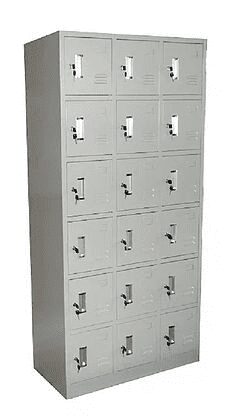Steel Locker Leyte
A steel locker in Leyte is a small, usually narrow storage compartment steel locker Leyte. They are commonly found in dedicated cabinets, very often in large numbers, in various public places such as locker rooms, workplaces, elementary schools,middle and high schools, transport hubs and the like. They vary in size, purpose, construction, and security.
Steel Locker Leyte is normally quite narrow, of varying heights and tier arrangements. Width and depth usually conform to standard measurements, although non-standard sizes are occasionally find. Public places with steel locker often contain large numbers of them, such as in a school. They are usually painted sheet metal.
Lockers are usually physically joined side by side in banks, and are commonly made from steel, although wood, laminate, and plastic are other materials sometimes found.
Steel locker Leyte which is banked together share side walls, and are constructed by starting with a complete locker;Lockers can be add by constructing the floor, roof, rear wall, door, and one extra side wall, with the existing side wall serving as the other side wall. The walls, floors, and roof can be rivete together or welded together.
Steel Locker Leyte
Locker doors usually have some kind of ventilation to provide for the flow of air to aid in cleanliness. These vents usually take the form of a series of horizontal angled slats at the top and bottom of the door. Although sometimes parallel rows of small square or rectangular holes are found instead, running up and down the door. Less often, the side or rear walls may also have similar ventilation.
Locker doors usually have door stiffeners fixed vertically to the inside of the door, protruding outward a fraction of an inch to make it harder to open.
Lockers are often manufacture by the same companies who produce filing cabinets. Stationery cabinets (occasionally wrongly referred to as lockers, steel shelving, and other products made from sheet steel.
Storage lockers are usually small, narrow compartments. Many public places have dedicated cabinets containing them, often in large numbers, including locker rooms, workplaces, elementary schools, middle and high schools, transport hubs, etc. They vary in size, purpose, construction, and security.
Characteristics and general description
It is common for lockers to be quite narrow, varying in height and tier arrangement. Public places with lockers often contain large numbers of them, such as in a school. They usually conform to standard measurements, although non-standard sizes are sometimes find. Sheet metal lockers are usually paint.
Usually, they are distinguish from other types of cabinets or cupboards by the following characteristics:
Usually, they have a lock or at least a padlocking facility (sometimes both).
A locker is usually use for storing clothing or other personal items in public places, as well as for short- or long-term private use by individuals. It is possible to rent a locker for a single use or for a period of time for repeated use. Some lockers are available free of charge to participants in certain activities.
Usually, but not always, there are several of them.
Lockers generally come in banks, and are usually craft of steel. Various materials such as wood, laminates, and plastic can be found occasionally. To construct them, a complete locker is need first; then the floor, roof, back wall, door and single extra side wall must be added. This extra side wall connects to that of the previous locker to finish making the new one. Riveting or welding are utilize for blending the walls, floors and roof together.
Steel Locker Leyte
To ensure cleanliness, locker doors usually have some kind of ventilation. Usually, these vents are horizontal angle slats at the top and bottom of a door, although sometimes parallel rows of small square or rectangular holes run up and down the door in place of these horizontal angled slats. Ventilation may also be found in the sides or rear walls less frequently.
Stiffeners are metal plates weld to the inside of locker doors, adding to the robustness of the door.
Lockers are manufacture by companies that produce filing cabinets, stationery cabinets, steel shelving, and other sheet steel products.
Lockers have a variety of characteristics
Recent developments involve keyless methods like coin deposit or electronic keypads to enter passwords when re-opening the locker. Drop-latch lockers have been replace by three-point locking systems with rotating latches.
Flush locks, cam locks, or locks incorporated into a rotating handle offer additional protection, while hasp and staples and latchlocks provide an alternative.
Steel Locker Leyte
In lockers, a number of features or characteristics may vary. It is more common to order a particular configuration rather than purchase one off the shelf in a store, as certain configurations can be found easily in shops. Among these are:
Bank size isn’t always the same as the amount of compartments; rather, it is the full width of the cabinet. A 3-bank unit can contain 6 lockers if they have a two-tiered design. Therefore, bank size is determine by multiplying it with the quantity of tiers. The term “bay” is sometimes used to denote this, while “bank” is more popularly use to refer to an individual locker’s width along with the tiers it contains in succession.
Lockers may be specified with a single, double, triple or higher tier designations, meaning that the lockers are arrange in a stack of two, three or more high. On occasion, particularly for laptop storage purposes, even more tiers can be found. Generally speaking, the most common numbers of tiers in lockers are one, two and four; three-tier lockers are less common and other numbers such as five, six or eight are extremely rare. The actual height of individual lockers depends on the number of tiers it accommodates.
The standard locker depth is 18 inches (46 cm.) and does not vary unless a special order is placed. Despite being virtually unknown in Australia, 12- and 15-inch deep lockers seem to have some currency in the U.S.
Steel Locker Leyte
Therefore two-tier lockers measure around 3 feet (91.4 cm.), whereas an extra tier reduces this to 2 feet (61 cm.) or 1.5 feet (45.7 cm.) for four tiers. Accessories also vary according to tier number; single-tier lockers tend to have a shelf at 1 foot from the top along with a hanging rail underneath it at the top of its large compartment below; two- and three-tier lockers lack a shelf but feature a rail for hanging items instead; those with four tiers or higher simply consist of bare compartments without any additional features.
Steel is the traditional material, but wood, plastic, or laminate can also be used. In places where moisture accumulates over time, steel lockers may rust, plastic or laminate lockers are sometimes recommend. They can also be used in external applications where internal space is not available.
The dimensions of lockers in English-speaking countries are usually inches or feet, but metric measurements are uneven, requiring decimal places for precision. This is due to locker designs being based on feet and inches for decades, unchangeable for cosmetic purposes.
Key locking and padlocking facilities are now available in various designs.
Lockers are usually designed in standard widths: 12 inches (30.5 cm.) wide is a common width, and 15 inches (38 cm.) has become increasingly popular recently. There are occasionally lockers of other widths, notably in the U.S., which are often narrower or (occasionally) wider.
Steel Locker Leyte
Lockers are typically secure with either single- or three-point locking, though purchasers may be able to select a different option. The type chosen usually depends on the number of tiers in the lockers or whether they are high-security models. Single-point locking is where only one point, where the latch connects to the door-frame, is locked. In contrast, three-point locking uses extensible steel rods to secure both the top and bottom of the door.
Locker cabinets have a standard height of 6 feet, and non-standard models must be ordered.
Some manufacturers offer two-tone coloring, where the doors and locker bodies are different colors. Lockers used to be dark grey some decades ago, but manufacturers now offer a variety of colors.
A locker is generally from 0.8 mm thick steel, which is a standard thickness. Heavy-duty and high-security lockers are typically steel of 1.2 mm thickness and equip with three-point locking, regardless of the number of tiers.
While most lockers have flat tops, some manufacturers offer sloping tops as an option. This makes it impossible for items to be store on top of the lockers, or makes it harder for dust or other debris to accumulate. It may be either 30 degrees or 45 degrees to the horizontal, with a slope towards the front. In places like food-processing factories and restaurants where hygiene requirements must be met, this is a crucial factor.

